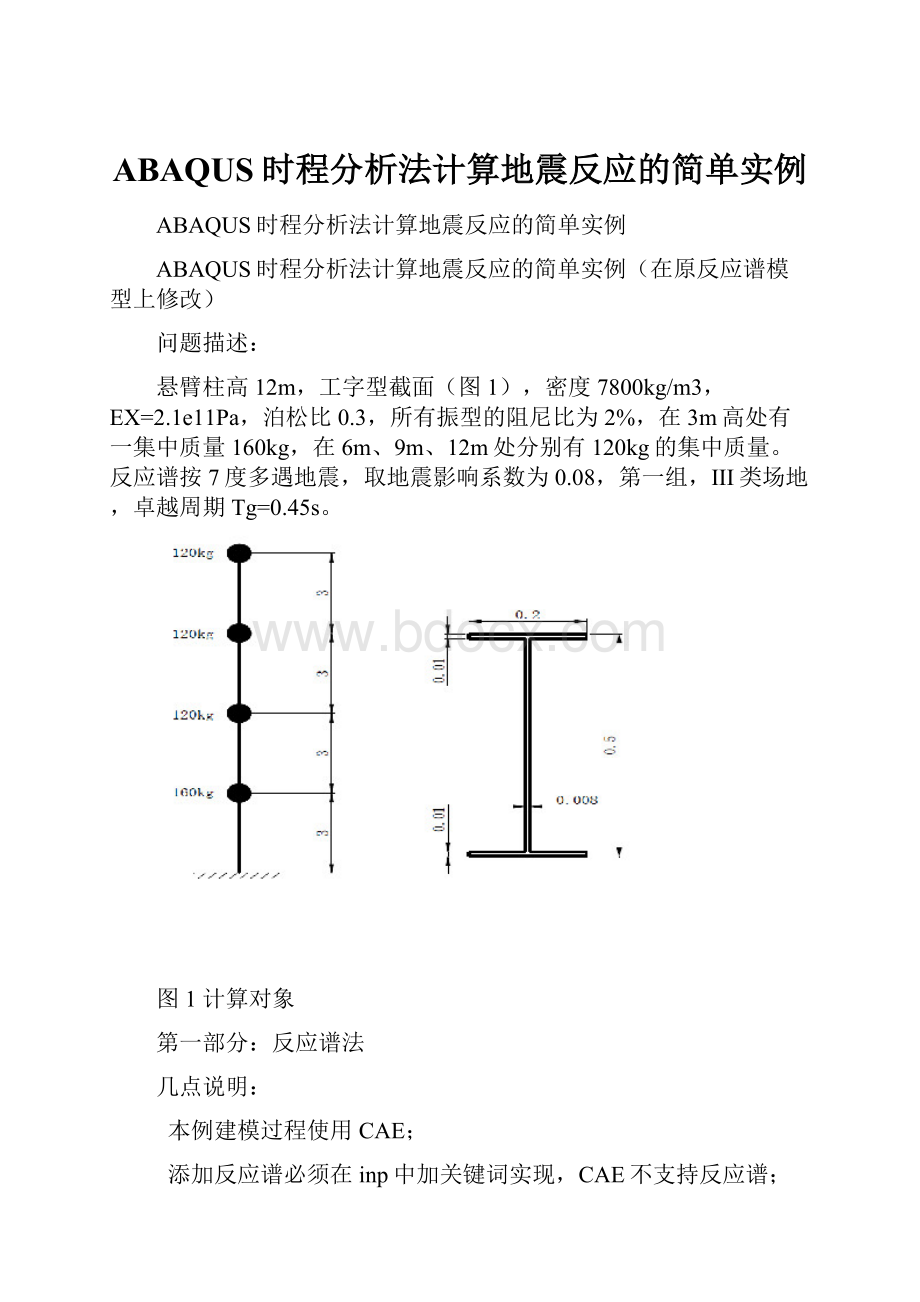ABAQUS时程分析法计算地震反应的简单实例.docx
《ABAQUS时程分析法计算地震反应的简单实例.docx》由会员分享,可在线阅读,更多相关《ABAQUS时程分析法计算地震反应的简单实例.docx(27页珍藏版)》请在冰豆网上搜索。

ABAQUS时程分析法计算地震反应的简单实例
ABAQUS时程分析法计算地震反应的简单实例
ABAQUS时程分析法计算地震反应的简单实例(在原反应谱模型上修改)
问题描述:
悬臂柱高12m,工字型截面(图1),密度7800kg/m3,EX=2.1e11Pa,泊松比0.3,所有振型的阻尼比为2%,在3m高处有一集中质量160kg,在6m、9m、12m处分别有120kg的集中质量。
反应谱按7度多遇地震,取地震影响系数为0.08,第一组,III类场地,卓越周期Tg=0.45s。
图1计算对象
第一部分:
反应谱法
几点说明:
本例建模过程使用CAE;
添加反应谱必须在inp中加关键词实现,CAE不支持反应谱;
*Spectrum不可以在keywordeditor中添加,keywordeditor不支持此关键词读入。
ABAQUS的反应谱法计算过程以及后处理要比ANSYS方便的多。
操作过程为:
(1)打开ABAQUS/CAE,点击createmodeldatabase。
(2)进入Part模块,点击createpart,命名为column,3D、deformation、wire。
continue
(3)Createlines
,在
分别输入0,0回车;0,3回车;0,6回车;0,9回车;0,12回车。
(4)进入property模块,creatematerial,name:
steel,general-->>density,massdensity:
7800
mechanical-->>elasticity-->>elastic,young‘smodulus:
2.1e11,poisson’sratio:
0.3.
(5)Createsection,name:
Section-1,category:
beam,type:
beam,
Continue
createprofile,name:
Profile-1,shape:
I,
按图1尺寸输入界面尺寸,ok。
在profilename选择I,materialname选择steel。
Ok
(6)Assignsection,选择全部,done,弹出的对话框选择section:
Section-1,ok。
(7)Assignbeamorientation
,选择全部,默认值确定。
(8)View-->>partdisplayoptions,在弹出的对话框里勾选,renderbeamprofiles,以可视化梁截面形状。
(9)添加集中质量,Special-->>inertia-->>create,name:
mass1,type:
pointmass/inertia,
continue,选择(0,3)位置点
done,mass:
160,ok。
create,name:
mass2,type:
pointmass/inertia,continue,选择0,6;0,9;0,12位置点(按shift多选),done,mass:
120,ok,dismiss。
(10)Assembly-->>instancepart,instancetype选dependent(meshonpart),ok。
(11)Step-->>createstep,name:
step-1,proceduretype选freqency,continue
在basic选项卡中,eigensolver选择频率提取方法,本例选用lanczos法,numberofeigenvaluesrequest,选value,输入10.ok。
再createstep,createstep,name:
step-2,proceduretype选responsespectrum,continue
在basic选项卡中,excitations选择单向singledirection,sumations选择squarerootofthesumofsquares(SRSS)法,useresponsespectrum:
sp(反应谱的name,后面再inp中添加),方向余弦(0,0,1),scalefactor:
1.
进入damping选项卡,阻尼使用直接模态(directmodal),勾选directdampingdata,startmode:
1,endmode:
8,criticaldampingfraction:
0.02.ok。
(12)进入load模块,Load-->>createboundarycondition,name:
fixed,step选择initial,category选择mechanical,types选择displacement/rotation,continue
选择0,0点,done,勾选u1~ur3所有6个自由度。
Ok。
(13)进入mesh模块,object选择part,点seededgebynumber,选择所有杆,done,输入3,done
点assignelementtype
,选择全部杆,done,默认B31,ok。
点meshpart,yes。
(14)进入job模块,name:
demo-spc,source:
model,continue,默认,ok。
进入jobmanager,点击writeinput,在工作目录生成demo-spc.inp文件。
(15)进入ABAQUS工作目录,使用UltraEdit软件(或其他类似软件)打开demo-spc.inp,*Boundary关键词的后面加如下根据问题叙述确定的反应谱:
*Spectrum,type=acceleration,name=sp
0.1543,0.167,0
0.1915,0.25,0
0.2102,0.333,0
0.2241,0.444,0
0.25,0.5,0
0.3295,0.667,0
0.4843,1,0
0.5987,1.25,0
0.7868,1.667,0
1.0342,2.222,0
1.0342,10,0
0.3528,10000,0
第一列为加速度,第二列为频率,第三列为阻尼比。
图2
保存。
(16)进入job模块,createjob,name:
spc,source选择inputfile,inputfileselect:
工作目录下的demo-spc.inp,continue
默认,ok,进入jobmanager,选择spc,submit,计算成功!
Frequencymustbeincreasingcontinuouslyinaspectrumdefinition
(17)点击results进入后处理模块,可以看到最大位移为3.159cm,这与陆新征博士讲解的ansys结果3.1611cm基本一致。
可以查看工作目录下的spc.dat文件查看详细的频率和模态分析结果。
第二部分:
时程分析
(1)进入step模块,删除原step1、step2。
建立step1(staticgeneral),用于施加重力
(2)将step1结果作为动态分析的初始状态,timeperiod设置为1e-10(很短时间)。
建立step2(dynamicimplicit),进行动力时程分析
timeperiod设置为20(施加的加速度记录共20s,间隔0.02s),type:
automatic,最大增量数量设置为2000步,将初始时间增量设置为0.02,最小增量设置为1e-15,最大增量设置为0.02,half-stepresidualtolerance:
100(控制automatic求解精度的值,在地震分析中应该设置多大为好?
还没弄清楚!
请大家赐教!
)。
另外,将非线性开关打开:
在StepManager对话框中点击Nlgeom
(3)将模型顶端节点设置为set-1:
tools-->>set-->>create(在tools中设置,用于观察顶端节点的反应情况),同样的方法,底端节点设置为set-2
在output中设置需要输出结果,在edithistoryoutputrequest将domain改为set,选择set1,在displacement里面选择U。
output-->>historyoutputrequest-->>manager-->>edit
CreatH-Output-2,选择set-2,同上
(3)进入property模块,materialeditor-->>edit-->>mechanical-->>damping在材料中补充damping,使用瑞利阻尼,质量系数alpha为0.15,刚度系数beta为0.01。
(3)进入load模块,boundaryconditionmanager,将fix在step2的propagated改为inactive(点击deactivate)
create一个新的边界条件(在step2),取消z向位移约束(以在该方向施加加速度)
再create一个边界条件(在step2),type为acceleration/angularacceleration,continue
选择基底节点,勾选A1,输入1(加速度记录单位m/s^2),
在amplitude后点create,name:
Amp-1,type:
tabular,continue
timespan:
totaltime从excel文件ac5复制时间和加速度至date数据栏中(加速度时程按规范将最大值调整为0.35m/s^2)
再amplitude下拉栏中选Amo-1,ok。
Dimiss
(4)进入job模块,Createjob,submit。
点击result
(5)result->historyoutput—>SpecialDisplacement:
U1atNode1inNSETSET—2
和U1atNode5inNSETSET—1(同时按住SHIFT键可同时选择)—>plot
(6)点击左“XYData”前的加号
出现
,对_temp_1,_temp_3分别单击右键,点击edit,可将时程数据导出到excel文件中,利用excel计算功能,算出相对位移(求差),再利用excel做出相对位移的时程曲线。
注:
原例中时程曲线如下
本算法得到的曲线如下图